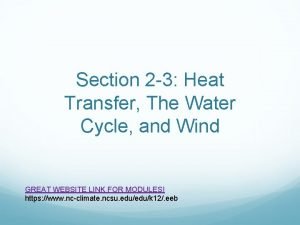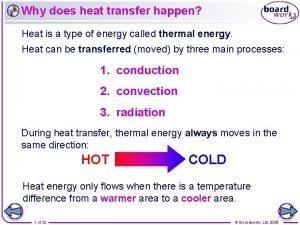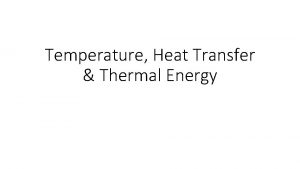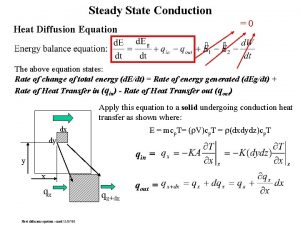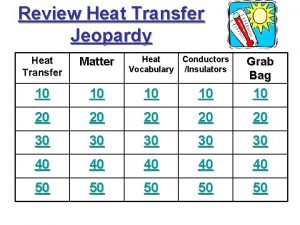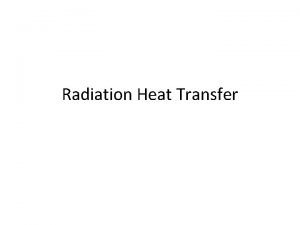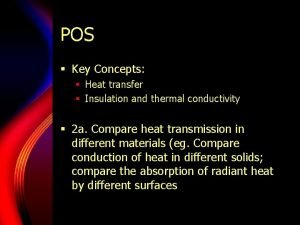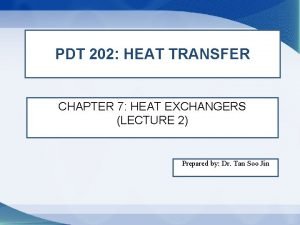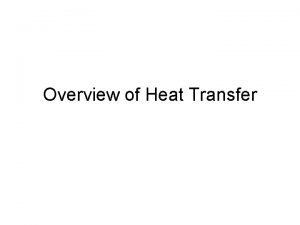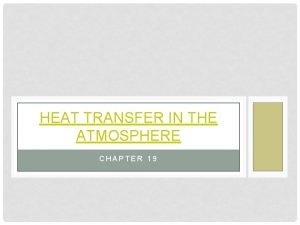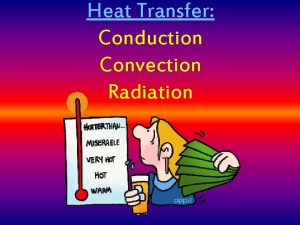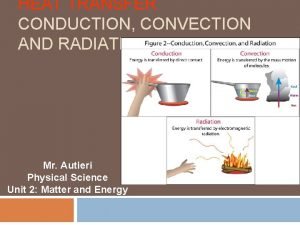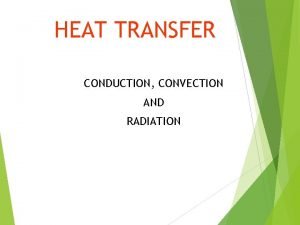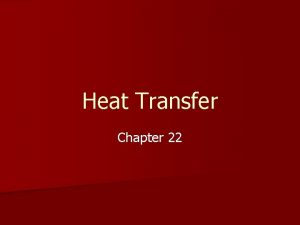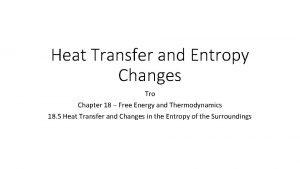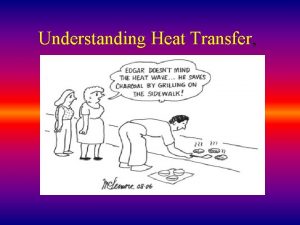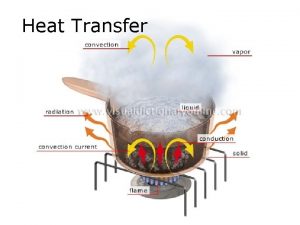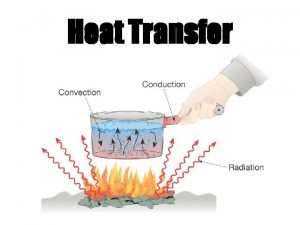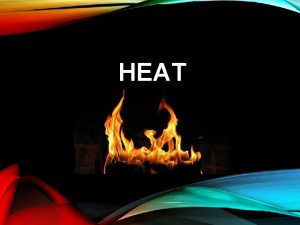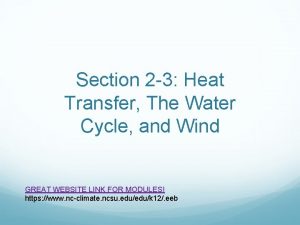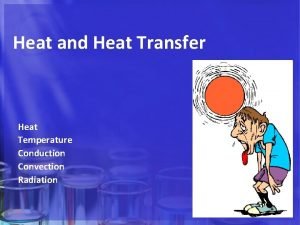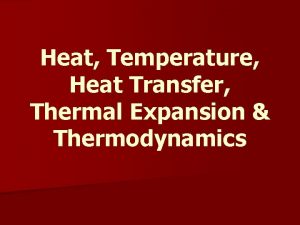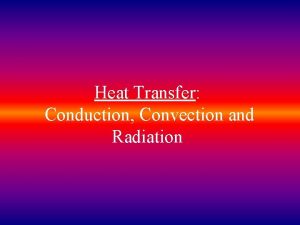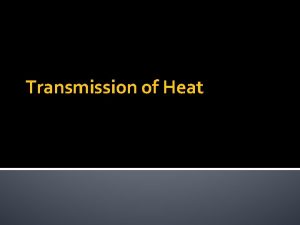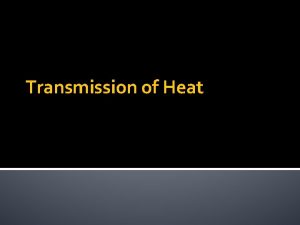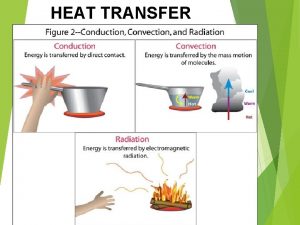Section 2 3 Heat Transfer The Water Cycle





























- Slides: 29

Section 2 -3: Heat Transfer, The Water Cycle, and Wind GREAT WEBSITE LINK FOR MODULES! https: //www. nc-climate. ncsu. edu/k 12/. eeb

Lesson Objective By the end of this lesson, you should be able to: a. ) Describe the main processes of the water cycle b. ) Explain how weather is related to water cycle processes c. ) Explain how energy from the sun drives wind and water currents d. ) Explain how energy from the sun is distributed around the globe

Questions To Ask Yourself I. ) How is the sun’s energy transferred around the globe? II. ) What is the water cycle and why is it important? III. ) How does the water cycle influence weather patterns? IV. ) How do winds form?

Vocabulary 1. ) Thermal Energy 11. ) Ground Water 2. ) Conduction 12. ) Transpiration 3. ) Convection 13. ) Photosynthesis 4. ) Radiation 14. ) Wind 5. ) Pressure Gradient Force 15. ) High Pressure 6. ) Water Cycle 16. ) Low Pressure 7. ) Evaporation 17. ) Sea Breeze 8. ) Precipitation 18. ) Land Breeze 9. ) Condensation 19. ) Convection Currents 10. ) run-off 20. ) Jet Stream

Video’s The Water Cycle: https: //www. youtube. com/watch? v=al-do-HGu. Ik Heat Transfer: https: //www. youtube. com/watch? v=l. P 40 H 9 K 5 Ykk Wind Circulation https: //www. youtube. com/watch? v=m 6 Fp. ZCM 5 qa. U

I. ) How is the sun’s energy transferred around the globe? *The Earth must maintain an Energy (or Heat) Balance!* Earth gains energy from the Sun (or warms) by Incoming Shortwave Radiation. Thermal energy is produced by incoming shortwave radiation Earth Sun Earth emits energy to space (or cools) by Outgoing Longwave Radiation m.

I. ) How is the sun’s energy transferred around the globe? Heat Transfer within the Earth’s Atmosphere

I. ) How is the sun’s energy transferred around the globe? The Role of Mid-Latitude Synoptic Systems Maintaining the Global Heat Balance • The Earth cool everywhere via radiation (the tropics, midlatitudes, and poles) • Due to the Earth’s small tilt with respect to its axis of rotation, the tropics received much more energy (heat) from the Sun than the polar regions • Thus, over time, a strong north-south gradient in temperature develops Nature hates strong gradients!!! The role of mid-latitude synoptic weather systems is to remove this gradient by transporting (or advecting) warm air poleward and cold air equatorward M. D. Eastin

I. ) How is the sun’s energy transferred around the globe? - Energy Transfer in weather occurs on a global scale, and energy from the sun has a huge impact on water and wind currents on Earth. - One way the sun affects weather is through wind patterns. - The shortwave radiation from the sun warms the ground, which in turn heats the air above it. - However, not all of the Earth’s surfaces absorb or radiate heat energy at the same rate. Land heats up and cools down more quickly than water does. This is due to sensible heating of water. - These temperature differences also affect the temperature of the air, causing weather patterns such as sea breezes and land breezes. - **The uneven heating of Earth by the Sun is therefore responsible for wind patterns, which in turn have a direct impact on weather. **

I. ) How is the sun’s energy transferred around the globe? Conduction: Direct heat transfer of heat energy from one substance to another (solids). Example: The sun warms Planet Earth. The surface of the Earth acts as a conductor as the shortwave radiation heats up the ground.

I. ) How is the sun’s energy transferred around the globe? Convection: Transfer of heat energy in a fluid, gas or liquid. Example: Wind currents develop within the Earth’s Atmosphere due to temperature and pressure differences. In order for heat to be transferred to other regions, it must be transferred horizontally by the wind. The horizontal transfer of heat by the wind is called advection.

I. ) How is the sun’s energy transferred around the globe? Radiation: the transfer of heat energy through empty space Example: Radiation from the sun hits Earth in the form of shortwave radiation. We feel the radiation (heat) from the sun. *Think of the Sun’s radiation*

I. ) How is the sun’s energy transferred around the globe? Wind: Air in natural motion due to different temperature or pressure differences within the Earth’s atmosphere. Advection of the wind moves warm air over cool air, or cool air below warm air. This type of air movement can produce convective currents within the Earth’s atmosphere. This is also due to high/low pressure within the atmosphere.

I. ) How is the sun’s energy transferred around the globe? The Role of Mid-Latitude Synoptic Systems Maintaining the Global Heat Balance • The gradients are continuously removed through the interaction of upper-level waves in the jet stream with large-scale high and low pressure systems near the surface

II. ) What is the water (hydrological) cycle, and why is it important? The Water Cycle: describes the continuous movement of water on, above and below the surface of the Earth. a. ) Evaporation: The changing of a liquid into a gas, often under the influence of heat (Evaporation from verga! ). b. ) Precipitation: is any product of the condensation of atmospheric water vapor that falls under gravity (rain, snow, sleet, or hail that falls to the ground). c. ) Condensation: is the change of the physical state of matter from gas phase into liquid phase (Clouds forming from water vapor. d. ) Surface Run-Off: is the flow of water that occurs when excess water from rain, melt water, or other sources flows over the earth's surface. This might occur because soil is saturated to full capacity, or because rain arrives more quickly than soil can absorb it. e. ) Ground Water: is the water located beneath the earth's surface in soil pore spaces and in the fractures of rock formations.

II. ) What is the water (hydrological) cycle, and why is it Important? f. ) Transpiration: is the process of water movement through a plant and its evaporation from aerial parts, such as from leaves but also from stems and flowers. g. ) Photosynthesis: the process by which green plants and some other organisms use sunlight to synthesize foods from carbon dioxide and water.

III. ) How does the water cycle influence weather patterns? - The sun’s energy affects the movement of water on Earth. This process is known as the water cycle, which is composed of three main phases: evaporation, condensation, and precipitation. - The sun’s heat causes water on Earth’s surface to change from a liquid to a gas form. The evaporated water then rises into the air. The higher the air mass gets, the cooler the air temperature becomes. - Eventually, the water vapor begins to condense into tiny droplets that form clouds in the sky. When the liquid droplets become heavy enough (fall through the updraft), they fall back to Earth as liquid or solid particles. - The water cycle helps to move the water around the Earth. - The movement of water through the water cycle causes weather patterns such as cloud formation and precipitation - Humidity is the measure of the amount of water in the air. The dew point is the point at which the temperature of the air and the humidity allow the formation of water droplets. When precipitation occurs, the humidity is 100% and the dew point has been reached

III. ) How Does the Water Cycle Influence Weather Patterns? - The water cycle is a critical element in weather patterns. Large bodies of water, such as oceans and lakes, feed the atmosphere with evaporated water. As the water vapor rises, clouds form and become heavy with precipitation. - Air currents move these clouds over land, where they eventually drop the water as precipitation. Areas like the Pacific Northwest and areas around the Great Lakes receive a lot of precipitation due to the water cycle.

Homework 1 “The Water Cycle” and Processes Draw “The Water Cycle” and the processes that go along with the cycle. Example: Precipitation, Condensation, Evaporation, Convection, infiltration, percolation, surface runoff, groundwater storage, transpiration, and photosynthesis.

IV. ) How do Winds Form? - Warm air is less dense than cooler air (Low Pressure). When the sun’s energy warms air, the warm air rises and the air pressure drops. - Cooler air is denser and therefore sinks (High Pressure). Air moves (advection) across Earth’s surface between areas of warm rising air and cool sinking air. Moving air is wind. - ***Wind is caused by differences in temperature and density fluxuations within the Earth’s atmosphere!!!!***

IV. ) How do Winds Form? Forces Driving Synoptic-Scale Air Motions 1. ) Pressure Gradient Force: The change in pressure measured across a given surface. - Pressure is a force per unit area - Air pressure is the weight (mass) of the atmosphere above a given location - Air pressure is a function of temperature and density - Air pressure decreases with altitude at a decreasing rate - Air always tries to flow down the pressure gradient from regions of high pressure toward regions of lower pressure → the pressure gradient force - The pressure gradient force is directly proportional to the magnitude of the gradient.

IV. ) How do Winds Form? Forces Driving Synoptic-Scale Air Motions Horizontal PGF – Coriolis Force Horizontal PGF: • Acts to accelerate air from regions of high pressure toward regions of low pressure 2. ) Coriolis Force: • Apparent force (Earth is rotating reference frame) • Always acts to accelerate air 90° to the right of the wind vector in the northern hemisphere • Magnitude is proportional to the wind speed Flow down the pressure gradient

Video: The Coriolis Effect https: //www. youtube. com/watch? v=i 2 mec 3 vgea. I

IV. ) How do Winds Form? Forces Driving Synoptic-Scale Air Motions Cyclonic Flow • Counter-clockwise flow (N Hemisphere) • Occurs in association with low pressure systems (called “cyclones”) Anticyclonic Flow • Clockwise flow (N Hemisphere) • Occurs in association with high pressure systems (called “anticyclones”) m. d. eastin

Jet Streams and Jet Streaks The Midlatitude Jet Stream: • 100 -400 miles wide • 500 -3000 miles long (non-continuous around the globe) • Winds speeds range 50 -200 knots • Located between 200 -400 mb (altitude of largest N-S pressure gradient) • Westerly flow in northern hemisphere (Why? ) • Faster moving pockets of air embedded within the Jet Stream § Moves/Bends/Buckles from day to day in response to large-scale heating / cooling § Play important roles in steering and intensifying/weakening surface highs and lows North Pole Equator

Video: Air Currents https: //www. youtube. com/watch? v=m 6 Fp. ZCM 5 qa. U

Wind Currents: air moving from an area of high pressure to an area of low pressure. Trade Winds: a wind blowing steadily toward the equator from the northeast in the northern hemisphere or the southeast in the southern hemisphere, especially at sea. Two belts of trade winds encircle the earth, blowing from the tropical high-pressure belts to the low-pressure zone at the equator. Prevailing Westerlies: are prevailing winds from the west toward the east in the middle latitudes between 30 and 60 degrees latitude. They originate from the highpressure areas in the horse latitudes and tend towards the poles and steer extratropical cyclones in this general manner. Polar Easterlies: are the dry, cold prevailing winds that blow from the high-pressure areas of the polar highs at the north and south poles towards low-pressure areas within the Westerlies at high latitudes. Doldrums: an equatorial region of the Atlantic Ocean with calms, sudden storms, and light unpredictable winds. Horse Latitudes: a belt of calm air and sea occurring in both the northern and southern hemispheres between the trade winds and the westerlies.

Homework #2 Global Wind Currents 1. ) I want everyone to draw out a globe 2. ) draw inside the globe the polar region (60 -90 degrees) to the equator (0 -30 degrees) and the mid latitudes (30 -60 degrees) 3. ) draw inside the globe the doldrums, trade winds, prevailing westerlies, and polar easterlies (DRAW THE WIND DIRECTIONS). 4. ) Draw an example of a convective current on the globe. Write out the Definitions for extra Credit (10 points)

Essential Standards: Understand how the cycling of matter in and out of the Atmosphere relates to Earth’s atmosphere , weather, and climate and the Effects of the atmosphere on humans. Clarifying Objectives: 7. E. 1. 2 Explain how the cycling of matter in and out of the Atmosphere and atmospheric conditions relate to weather patterns on Earth. 7. E. 1. 5 Explain the influence of convection, global winds, and the jet stream on weather and climate conditions. Essential Questions: 7. E. 1. 2 How do weather patterns exist in the Earth’s Atmosphere? How does the water cycle influence and drive weather conditions on Earth? What factors influence your daily weather variations? Why is the study of meteorology important? 7. E. 1 What is the relationship between energy transfer and the Earth’s weather? How do heating systems and wind currents within the atmosphere influence weather conditions? How does gravity impact the jet stream? Learning Targets: 7. E. 1. 2 I can explain the significance of the water cycle and how it relates to weather patterns on Earth. 7. E. 1. 5 I can explain the influence of radiation, convection, and conduction in relation to the atmosphere. I can explain the influence of convective currents, global winds, and the jet stream on weather conditions. Learning Outcomes: 7. E. 1. 2 I will model and illustrate the water cycle. I will explain the different phases of the water cycle. 7. E. 1. 5 I will identify the differences in conduction, convection, and radiation within the Earth’s atmosphere. I will explain why and how winds curve due to the coriolis force.
 Convection water cycle
Convection water cycle Water and water and water water
Water and water and water water Water to water heat exchanger
Water to water heat exchanger Water cycle brain pop
Water cycle brain pop Water cycle the hydrologic cycle
Water cycle the hydrologic cycle A disturbance in a field that carries energy
A disturbance in a field that carries energy Heat transfer on metal
Heat transfer on metal Seven fundamental
Seven fundamental How is thermal energy transferred?
How is thermal energy transferred? Sound energy examples
Sound energy examples Diffusion equation
Diffusion equation Jeopardy conductor
Jeopardy conductor Example of heat transfer by radiation
Example of heat transfer by radiation Single effect evaporator calculations
Single effect evaporator calculations Conduction vs insulation
Conduction vs insulation Steam condenser heat exchanger
Steam condenser heat exchanger Heat transfer overview
Heat transfer overview Heat transfer
Heat transfer Ntu heat transfer
Ntu heat transfer We transfer
We transfer Types of heat transfer
Types of heat transfer Heat transfer on earth
Heat transfer on earth Sunlight melts a wax crayon left outside.
Sunlight melts a wax crayon left outside. Types of heat transfers
Types of heat transfers What is heat transfer conduction convection and radiation
What is heat transfer conduction convection and radiation Heat transfer
Heat transfer Examples of conduction convection radiation
Examples of conduction convection radiation Chapter 22 heat transfer exercises answers
Chapter 22 heat transfer exercises answers Entropy and heat transfer
Entropy and heat transfer Heat transfer videos
Heat transfer videos
